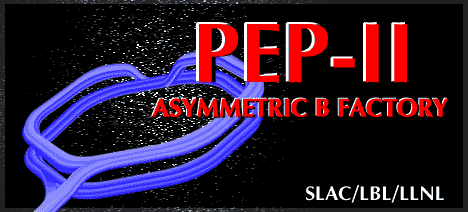 05/18/99 Update
05/18/99 Update
 05/18/99 Update
05/18/99 Update
The previous PEP-II commissioning run ended February 22, 1999, to install the BaBar detector and make several accelerator upgrades. After removal of the interaction region components and supports, BaBar arrived on the beam line March 13. From then until May 11 the accelerator was restored and BaBar's utilities reinstalled.
During the down many upgrades were completed. Several major components of the positron production system including the high gradient capture section , energy collimating chicane, and the downstream accelerating sections were replaced. Two energy collimators and four betatron collimators were installed in the LER. Many small LER vacuum leaks were repaired. Two new vacuum chambers and additional pumps were added in the HER just upstream of the interaction region. Special vacuum bellows (frangible links) were installed near the IP allowing BaBar to be isolated from the accelerator during an earthquake. The silicon vertex tracker (SVT) was installed inside the support tube around the beryllium vacuum chamber. New high-power larger-bore Q2 vacuum chambers were installed raising the last remaining administrative limits on the beam current to above the design values. Solenoid coils were wound over three adjacent 6 m straight section vacuum chambers in the LER to allow at test of suppression of pressure increases from suspected electron multipacting. Pole shims were added to two injection line dipoles.
During the down the radiation trip thresholds for the various BaBar sub-detectors were reviewed and set to the following values: 10 mrad/sec for the silicon vertex tracker, 1.3 mrad/sec for the drift chamber electronics, and 0.02 mrad/sec for the forward calorimeter CsI crystals. These values are about a factor of ten tighter than the February commissioning thresholds. It has been decided to stay within these thresholds for the foreseeable future.
System checkouts started early. The PEP-II RF systems began testing April 24. The BaBar solenoid was operated at full field in situ starting May 4. The PEP-II vacuum was completed and pumped down on May 9. The last remaining radiation shielding and final system checks were completed on May 11.
The first electron beam reached PEP-II on the morning of May 12 and passed through BaBar for the first time May 12 at 22:14 hours. Several shifts of background monitoring tests and calibrations were done. The first positron beam reached BaBar on the morning of May 15. By the evening of May 15 both rings had stored single bunch beams using 1 Hz injection with the solenoid off. By Monday morning May 17 both rings had multiple bunches stored with 10 mA total current. This current has been our administrative limit until we became comfortable with the background monitor calibrations and trip thresholds.
The injection efficiency of positrons used to be hindered by the large spot size mismatch just upstream of the LER. With the dipole shims recently installed, the mismatch has been completely fixed with the spot size now about 5 times smaller than before and comparable to the electron injected beam size.
So far, neither ring has recovered to the February conditions although only a few days of beam time has been available. The vertical tunes in both rings had to be raised by 0.1 units and the coupling changed substantially in order to inject initially. Alignment data say that the support tube containing the permanent magnets may be up to a millimeter low. Confirmation is in progress.
Over the past two days, the old LER tunes have been restored but coupling and vertical dispersion need correction. With the newly reduced injected beam sizes, the positron injection efficiency is near 100%. Injection at 1 Hz rarely trips BaBar. At 10 mA the stored beam backgrounds are about 10% of the trip threshold. The positron lifetime at 1 mA is 280 minutes.
If the vertical tune in the HER is restored to the February value, the lifetime and injection efficiency suffer. We have decided to stay at the higher tune until the lattice issues are resolved. At the high vertical tune the electron lifetime at 1 mA is about 300 minutes and the injection efficiency is near 100% with few BaBar trips. With 10 mA of stored electrons the backgrounds are also about 10% of the trip thresholds.
This morning the administrative current limit was raised to 25 mA.
Future plans call for colliding beams without the solenoid on May 19, installing the final two permanent magnet skew quadrupoles near BaBar for solenoid compensation on May 20, and learning to compensate the solenoid with beam over the week end. The run ends August 31.
A warm thanks to all the installation and checkout crews for a job well done. The down was very productive and the beams were rapidly restored.
Thanks again to all, John Seeman 5/18/1999
Suggestions to: John Seeman
[PEP-II Commissioning Updates] [PEP-II Home Page] [BABAR Detector Home Page] [SLAC Home Page]
Page owner: achan